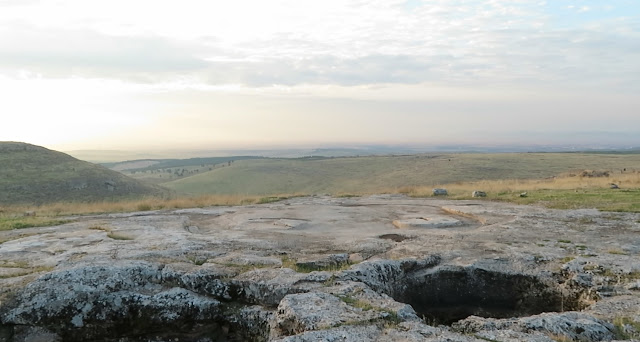How old is Gobekli Tepe? (updated)
Enclosure E, outside the main excavation area.
In an earlier post I suggested the earliest phase of construction of GT could be in the Younger Dryas period. This is because enclosure D is so well crafted and so large, that it is unlikely to have been the first construction of its kind. Other enclosures must have preceded it, acting as templates or precursors for its design.
Given that ground penetrating radar scans show that other large structures remain to be uncovered, and that the enclosures excavated so far represent only 5-10% of the site, it seems unlikely we have excavated the oldest parts already. This idea is reinforced by the existence of enclosure E outside the main excavation area. It seems to be a rougher and less precise example than enclosure D, and so could be a precursor. Since it is missing its walls and pillars, it is possible they were re-used in the construction of enclosure D. It has not been radiocarbon dated.
But what about scientific evidence? Let's consider the facts. Regarding radiocarbon dates, the earliest radiocarbon dates reported so far for Göbekli Tepe are (Dietrich, 2013);
1. A measurement (KIA-44149) on charcoal particles from within mortar that binds the wall of enclosure D, from between pillars 41 and 42 in the north-west of the wall, with a (95.4%) calibrated radiocarbon age of 9,530 ± 200 BCE.
2. A measurement (UGAMS-10796) from a hearth just outside and north-east of enclosure D close to the bedrock, with a radiocarbon age (95.4%) of 9,530 ± 200 BCE.
Both of these measurements have been re-calibrated using the
latest radiocarbon calibration curve (Reimer et al., 2020). Clearly, they are
in excellent agreement.
However, according to Kinzel and Clare (2020), the earliest phase of construction (phase 1) of Enclosure D corresponds to a section of the southern wall (shown in dark blue above), and the north-west part of the wall that has been radiocarbon dated (KIA-44149) seems to belong to a later phase (light blue or yellow in Figure 3.12 of Kinzel and Clare, 2020, see above). Regarding the phase 1 construction, they state,
“Although radiocarbon dates are lacking for this phase, it
likely belongs to the second half of the 10th millennium cal BC (PPNA), though
an earlier (Younger Dryas) age cannot be ruled out.”
This appears to contradict the above radiocarbon dates,
since phase 1 apparently precedes that part of the wall dated to 9,530 ± 200
BCE. Since the date of this part of the wall is supported by an identical date from a
hearth close to bedrock from outside of the enclosure, we can conclude that the
earliest phase of construction of enclosure D is unknown, but is likely to be
somewhat older than 9,530 BCE. Clearly, a Younger Dryas origin for enclosure D
is entirely reasonable.
Therefore, Kinzel and Clare's statement above seems to underplay the likely age of GT. I wonder why? It's as though they don't want GT to be as old as I suggest it is? It seems they want to avoid the idea that GT's symbolism could be related to the Younger Dryas impact. Hmm....





Comments
Post a Comment